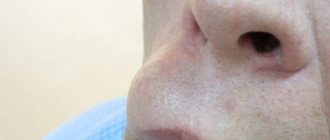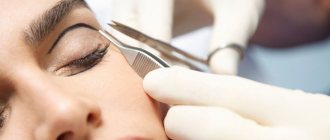Methods for removing tumors
Depending on the clinic, patients are offered various ways to combat the external manifestations of HPV.
Removal methods:
- Surgical.
- Laser removal.
- Electrocoagulation.
- Radio wave therapy.
- Cryodestruction.
Surgical excision is performed if degeneration of papilloma is suspected. To make an accurate diagnosis, the removed tumor is sent for histology. It is not possible to study the material using other methods of exposure.
Laser removal is considered the most attractive, as it is characterized by minimal intervention. The specialist determines the power and depth of the impact, so healthy tissues do not suffer. The wound heals after this method in just ten to fourteen days, which attracts many patients. In addition, the likelihood of scar formation is minimized, which is important when removing tumors in the facial area.
Preparation process for laser removal
Whatever method of papilloma removal you choose, you must undergo several tests:
- Testing for the virus involves taking a smear, in women from the cervix, in men from the urethra. The presence of RNA of the infectious agent in the submitted materials is checked.
- A chlamydia test also involves scraping or drawing blood. Chlamydia is a sexually transmitted disease transmitted through sexual contact.
- Flora analysis is a smear that allows you to determine the presence of pathogenic bacteria in the patient’s body, as well as cancer cells.
In addition, you must follow a few simple rules:
- do not sunbathe or visit a solarium;
- use sunscreen before going outside;
- do not take medicinal baths;
- Avoid contact of household chemicals with the affected area of the skin.
What happens to the wound after papilloma removal
The first few days there is an open wound on the skin, which becomes a source of potential threat. To reduce risks, you need to know how the wound behaves and how long it takes to fully recover.
First, severe inflammation and slight swelling occur at the removal site. They pass within a day, sometimes two days. Then a scab begins to form, that is, a small crust that performs protective functions. Thanks to it, the likelihood of infection entering the wound opening is reduced. If crust formation does not begin, you should definitely visit a specialist. Also, the attending physician can tell you what to do after removing the papilloma in each specific case. However, there are general recommendations that will help reduce the likelihood of complications.
Consequences of removal and side effects
Side effects after laser surgery are similar in appearance to thermal burns. For a short time, slight redness of the skin may persist at the treatment site, which goes away on its own.
People with hypersensitive skin may notice the formation of blisters that should not be touched. They heal on their own, leaving behind barely noticeable scars or pale white spots.
If you are prone to allergic reactions to sunlight, then after the procedure you may experience swelling and hyperemia of the skin. In this case, you should definitely seek medical help.
Removal of papillomas with laser - before and after the procedure
General recommendations
Some people immediately return to their normal lives after getting rid of an annoying cosmetic defect. They forget that the area of intervention requires competent care, on which human health depends. In the most unfavorable cases, you can provoke the development of skin cancer, which, even with the modern level of medical development, is difficult to treat.
What not to do:
- Wet the wound after removing the papilloma.
- Apply tonal and cosmetic products to the damaged area.
- Expose the injured area to sunlight.
- At first, visit baths, saunas and public swimming pools.
- Cover the wound with an adhesive plaster or apply a bandage.
- Remove the crust yourself.
If you tear off the scab prematurely, you can cause scar tissue to form. When visiting a bathhouse or public swimming pool, the risk of infection increases. Sticking the patch prevents the formation of a crust, which protects the new skin from damage. Also, you should not rub the wound with a pumice stone or scrub, as the delicate tissues will be injured. All this greatly slows down healing, which takes months.
Symptoms of the disease
Different types of papillomas manifest themselves in their own ways. A person with a strong immune system may have no obvious signs of the disease. Obvious symptoms of tumor development appear with decreased immunity, prolonged stressful situations and chronic diseases. Pregnancy can also lead to papillomas.
Condylomas are always inextricably linked with a weakened immune system. Genital warts are beige or light pink in color, rough to the touch, and are located on the genitals of both men and women. They have an unsightly aesthetic appearance and cause discomfort during sexual intercourse. The possibility of bleeding complicates natural childbirth.
Warts are a benign type of papilloma, located mainly on the arms and legs and having a color similar to the color of the skin.
Cervical cancer is a neoplasm that has degenerated into a malignant tumor. Women affected by this virus need to undergo biopsy tests.
Symptoms of the tumor include pain during sexual intercourse and a burning sensation. Later, pain is felt from any touch.
Successful treatment depends on timely detection of the source of inflammation. To do this, you need to regularly visit the gynecologist's office for a preventive examination.
How to treat a wound after removal of papillomas
Many people do not know how to treat a wound after removal of papillomas and how to do it correctly. The reason for the confusion is understandable, since some remedies are too aggressive. The wound they treated begins to peel off, and the recovery process is delayed.
The best option is to treat the wound with iodine or brilliant green. They are considered the safest and do not cause allergic reactions. Some experts advise treating the damage with a solution of potassium permanganate or calendula. Such recommendations are dangerous, since these drugs often provoke itching and allergic reactions.
Causes of tumor appearance
The main causes of infection with the virus are considered to be sexual intercourse, physical contact and sharing objects with an infected person.
It doesn’t matter what type of sex you prefer - classic, anal or oral, the use of a condom also does not play any role, the process of transmission of the virus occurs through close contact of bodies not covered with clothing.
There is a high risk of infection when visiting public places with high humidity - baths, saunas or swimming pools.
An interesting aspect of the disease is its incubation period - it can last from several months to several years, beginning to develop when the immune system is weakened or the body is weakened due to stress.
In “sleep” mode, the virus is completely safe for others; the risk of infection appears if the patient has warts.
About 60% of the world's population are carriers of human papillomavirus (HPV).
For most of them, the virus behaves calmly in the body, without betraying its presence.
But more than 20% of carriers suffer from the appearance of neoplasms on the skin, more often benign, less often malignant.
Papillomas grow on the membranes of internal organs, mucous membranes, and on the surface of the skin.
Growths like to appear on the body in hard-to-reach places: in men, most often in the genital area, in women - on the chest and nipples.
But is the appearance of papillomas on the chest dangerous? What consequences can a woman have and how to get rid of unpleasant warts?
Why do they appear?
The culprits of the appearance of warts, condylomas and other similar growths on the skin are viruses from the papillomavirus family, of which more than 600 strains have already been identified.
Most of them are harmless, some affect the formation of benign papillomas, other types can cause cancer, having oncogenic properties.
A disease called papillomatosis can have a long latent (asymptomatic) course, sometimes for several years.
What can you apply to a wound?
After the crust has disappeared, various medicinal ointments can be applied. The most popular is hydrocortisone ointment. It helps relieve itching that accompanies the restoration of the dermis. Local inflammation and swelling are also reduced. If you don’t know what to apply to the wound, you can safely choose this drug. Moreover, it does not penetrate into the general bloodstream, but only has a local effect.
Methyluracil is prescribed by specialists to treat wounds after removal of papilloma to reduce negative manifestations. The ointment promotes tissue regeneration and has an analgesic effect. For best results, apply this product 2 times a day.
Solcoseryl accelerates regeneration and stimulates local cell activity. Thanks to the use of this product, the appearance of scars and scars is excluded, since solcoseryl is responsible for the production of collagen. If the wound begins to become wet and a protective crust does not form, Solcoseryl gel should be applied. When the protective film appears, switch to ointment.
In order for the recovery process to be productive, it is necessary to use solutions that contain vitamins B and E. To prevent relapses of the disease, a general strengthening of the immune system is required, for which patients are recommended to take a course of vitamin complexes. Be sure to use ascorbic acid, tincture of ginseng or echinacea. Walking in the fresh air and dosed physical activity are a good addition.
Proper treatment after papilloma removal allows you to avoid complications. Within a few months, new skin will form at the site of the skin defect, which will not differ from the surrounding tissue. However, to do this, you should choose a good specialist who will first examine the tumor, identify all the risks and suggest the optimal method of removal. Only with this approach will papillomas not appear again after removal, and the person will not face the serious consequences of improper medical intervention.
Electrocoagulation of papillomas or laser?
This is a method in which high-frequency current acts directly on the tumor. Painful sensations arise due to the fact that the heat from the knife dissipates into the surrounding tissues and acts on their nerve endings. Excessive heat dissipation into the tissue is associated with poor healing and severe scarring. Laser removal of papillomas produces much less heat into the surrounding tissue, so such effects are not as pronounced. After electrocoagulation, the area where the papilloma was located becomes burned. To avoid pain, you can use local anesthesia, which is injected under the skin with a thin needle. If there are many papillomas, it is impossible to administer anesthesia to all of them at once due to restrictions on the maximum dose of anesthetics. Removing papillomas with a laser and electrocoagulation takes approximately the same amount of time, if without anesthesia - only a few seconds.
Advantages of electrocoagulation:
- It's done quite quickly.
- There is no blood.
- Accessible to many people, as this procedure is not expensive.
Disadvantages of electroagulation:
- The painfulness of the procedure is more pronounced than when removing papillomas with a laser, if anesthetics are not used. And for many people they are contraindicated.
- Long period of wound healing.
- The cosmetic result is far from ideal.
Possible complications
Complications and side effects from laser exposure are very rare.
- The most common side effect is infection of the wound during the recovery period. But such a problem arises very rarely, since after the procedure a dry mark remains, which very quickly becomes overgrown with a crust. The problem is created by the patient himself when he touches the treated area with unwashed hands. As a result, treatment with local antiseptics is required, and if the process is severely advanced, then with antibiotics.
- Relapse: the appearance of new growths in place of the removed ones. If a highly active human papillomavirus has caused the appearance of numerous growths, eliminating only the visible manifestations of the virus will not be enough. Before or after the session, it is necessary to undergo treatment with immunocorrective medications recommended by the doctor in order to restore and regulate the functions of the body's defense system.
In rare cases, complications occur











